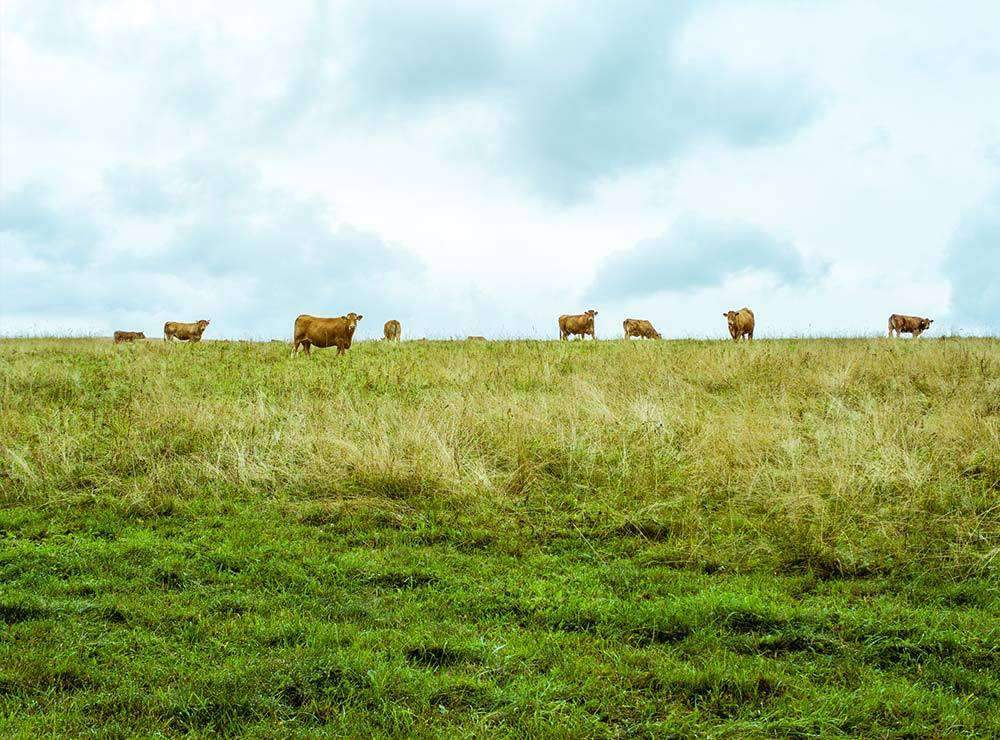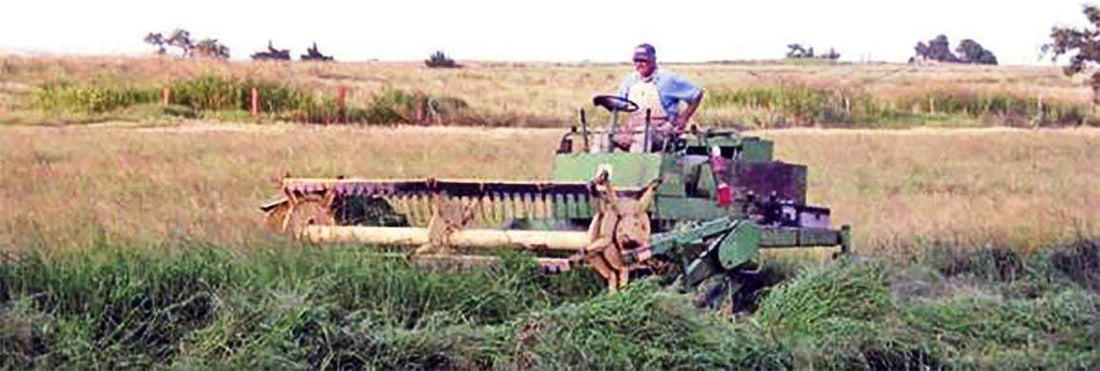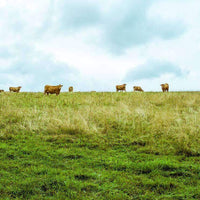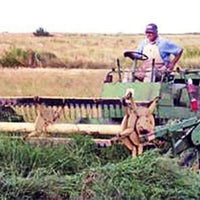
- When to plant:
- Spring, Summer
- Fertilizer:
- Varies
- Seeding rate:
- 6 lbs. per acre
- Overseeding rate:
- 3 lbs. per acre
- Seeding depth:
- 1/4 inch
- Ideal ph:
- 6.0 - 7.0
- Gmo:
- No
- Inoculant needed:
- No
- Coated or raw:
- Raw
- Lifecycle:
- Annual
- Climate zones:
- Transition Zone, Warm Season
Quick-N-Big Crabgrass was developed mainly for it's faster germination and quick growth in the spring and early summer. Quick-N-Big Crabgrass is more of a stooling grass than the Red River variety. Quick-N-Big Crabgrass is excellent for more northern regions, where Crabgrass is grown.
Product Information
- Application or Use: Pasture, Cattle Forage, Livestock Grazing, Hay Production
- Germination Time: 7 - 14 days, under optimal conditions
- Growing Locations: Warm Season, Transition Zone, Cool Season
- Height: 3 - 6 feet
- Sunlight Requirements: 8+ hours, full sun for best results
- Advantages: Early germination, less seed dormant, superior seedling vigor, and outstanding grazing/tonnage potential.
- When to Plant: Recommended planting time is spring, summer and early fall when night time temperatures are consistently 65+ degrees.
Product Detail
- Fast germination
- Hay production
- Higher yields
- Sandy or clay loam soils
- Well drained soil
Product Information
"Quick-N-Big" Crabgrass Seed has its name because it germinates faster, grows quicker, reaches grazing stage—or hay stage or maturity—quicker. Quick-N-Big is a bigger, taller plant than Red River. This species of Crabgrass does have runners, but not as many as Red River. For hay production, be sure not to allow Quick-N-Big to pass maturity, and harvesting height should be higher than Red River or Bermuda Grasses.
Quick-N-Big Crabgrass produces faster growth and higher yields earlier than Red River Crabgrass.
Crabgrass is generally thought of as a weed, but many cattlemen in the southern regions of the United States consider it a high-producing, high-quality forage in a double-cropping system behind small grain Winter annual forages such as Wheat, Rye, and Triticale. Crabgrass is a Summer annual forage which is propagated by seed, either volunteer or planted.
*Product packaging may appear different than what is pictured.
Plant between spring and fall at a rate of 3 to 6 lbs. per acre. Plant at a depth of 1/4 in.
Crabgrass is adapted to many soil types but grows best on sandy and clay loam soils with good drainage Crabgrass can be utilized by either grazing or haying. Grazing of Crabgrass should begin when the plants reach 4 to 6 in. tall. Haying should occur on a schedule to minimize the production of seedheads, since forage quality is best before allowing seedhead production.
Soil fertility is critical in maximizing both forage quality and quantity. Phosphorus and Potassium levels should be applied according to soil tests, and applications of as much as 150 lbs. of actual nitrogen in split applications can be applied throughout the Summer to maintain production. Rainfall and fertility determine stocking rates. With sufficient moisture and nitrogen, stocking rates of 800 to 1200 lbs. of live weight are possible. Stockers have gained in excess of 1.5 lbs. per day in suitable conditions.
When choosing to start a new lawn, remove old vegetation by using a de-thatcher, power rake or tiller to kill the existing vegetation. Rake or drag the area to remove debris and dead grass for a clean area. Ensure the soil is leveled and loosened to allow the seed to have good soil contact once spread on a clean seed bed.
If you have an area with heavy weed coverage, we recommend starting fresh by killing and removing the existing vegetation. If you choose to use chemicals, herbicides or fertilizers, you must check with the product's manufacturer prior to planting new seed to ensure the proper waiting period.
When overseeding an existing area, mow your lawn at the lowest setting and bag the clippingsx. Rake or drag any areas that have dead thatch or debris.

Seed Quality
Hancock Seed is dedicated to delivering the best seeds possible to our customers. Hancock Seed grows and harvests many of our products, and we acquire the majority of the rest from other family farmers.
All these seeds are processed, packaged and shipped from Hancock Farm. This helps us ensure that our high standards are met. Unlike much of the competition, we refuse to sell you a seed that was not gathered during the last harvest. You will always receive fresh product from Hancock.
Every seed we grow comes with 40 years of experience behind it...you can rest assured that all of our products are cultivated in a method that assures its potential for growth.

Your cart ( 0 )

Quick-N-Big Crabgrass was developed mainly for it's faster germination and quick growth in the spring and early summer. Quick-N-Big Crabgrass is more of a stooling grass than the Red River variety. Quick-N-Big Crabgrass is excellent for more northern regions, where Crabgrass is grown.
Product Information
- Application or Use: Pasture, Cattle Forage, Livestock Grazing, Hay Production
- Germination Time: 7 - 14 days, under optimal conditions
- Growing Locations: Warm Season, Transition Zone, Cool Season
- Height: 3 - 6 feet
- Sunlight Requirements: 8+ hours, full sun for best results
- Advantages: Early germination, less seed dormant, superior seedling vigor, and outstanding grazing/tonnage potential.
- When to Plant: Recommended planting time is spring, summer and early fall when night time temperatures are consistently 65+ degrees.
Product Detail
- Fast germination
- Hay production
- Higher yields
- Sandy or clay loam soils
- Well drained soil
Product Information
"Quick-N-Big" Crabgrass Seed has its name because it germinates faster, grows quicker, reaches grazing stage—or hay stage or maturity—quicker. Quick-N-Big is a bigger, taller plant than Red River. This species of Crabgrass does have runners, but not as many as Red River. For hay production, be sure not to allow Quick-N-Big to pass maturity, and harvesting height should be higher than Red River or Bermuda Grasses.
Quick-N-Big Crabgrass produces faster growth and higher yields earlier than Red River Crabgrass.
Crabgrass is generally thought of as a weed, but many cattlemen in the southern regions of the United States consider it a high-producing, high-quality forage in a double-cropping system behind small grain Winter annual forages such as Wheat, Rye, and Triticale. Crabgrass is a Summer annual forage which is propagated by seed, either volunteer or planted.
*Product packaging may appear different than what is pictured.
Plant between spring and fall at a rate of 3 to 6 lbs. per acre. Plant at a depth of 1/4 in.
Crabgrass is adapted to many soil types but grows best on sandy and clay loam soils with good drainage Crabgrass can be utilized by either grazing or haying. Grazing of Crabgrass should begin when the plants reach 4 to 6 in. tall. Haying should occur on a schedule to minimize the production of seedheads, since forage quality is best before allowing seedhead production.
Soil fertility is critical in maximizing both forage quality and quantity. Phosphorus and Potassium levels should be applied according to soil tests, and applications of as much as 150 lbs. of actual nitrogen in split applications can be applied throughout the Summer to maintain production. Rainfall and fertility determine stocking rates. With sufficient moisture and nitrogen, stocking rates of 800 to 1200 lbs. of live weight are possible. Stockers have gained in excess of 1.5 lbs. per day in suitable conditions.
Instructions
When choosing to start a new lawn, remove old vegetation by using a de-thatcher, power rake or tiller to kill the existing vegetation. Rake or drag the area to remove debris and dead grass for a clean area. Ensure the soil is leveled and loosened to allow the seed to have good soil contact once spread on a clean seed bed.
If you have an area with heavy weed coverage, we recommend starting fresh by killing and removing the existing vegetation. If you choose to use chemicals, herbicides or fertilizers, you must check with the product's manufacturer prior to planting new seed to ensure the proper waiting period.
When overseeding an existing area, mow your lawn at the lowest setting and bag the clippingsx. Rake or drag any areas that have dead thatch or debris.




















